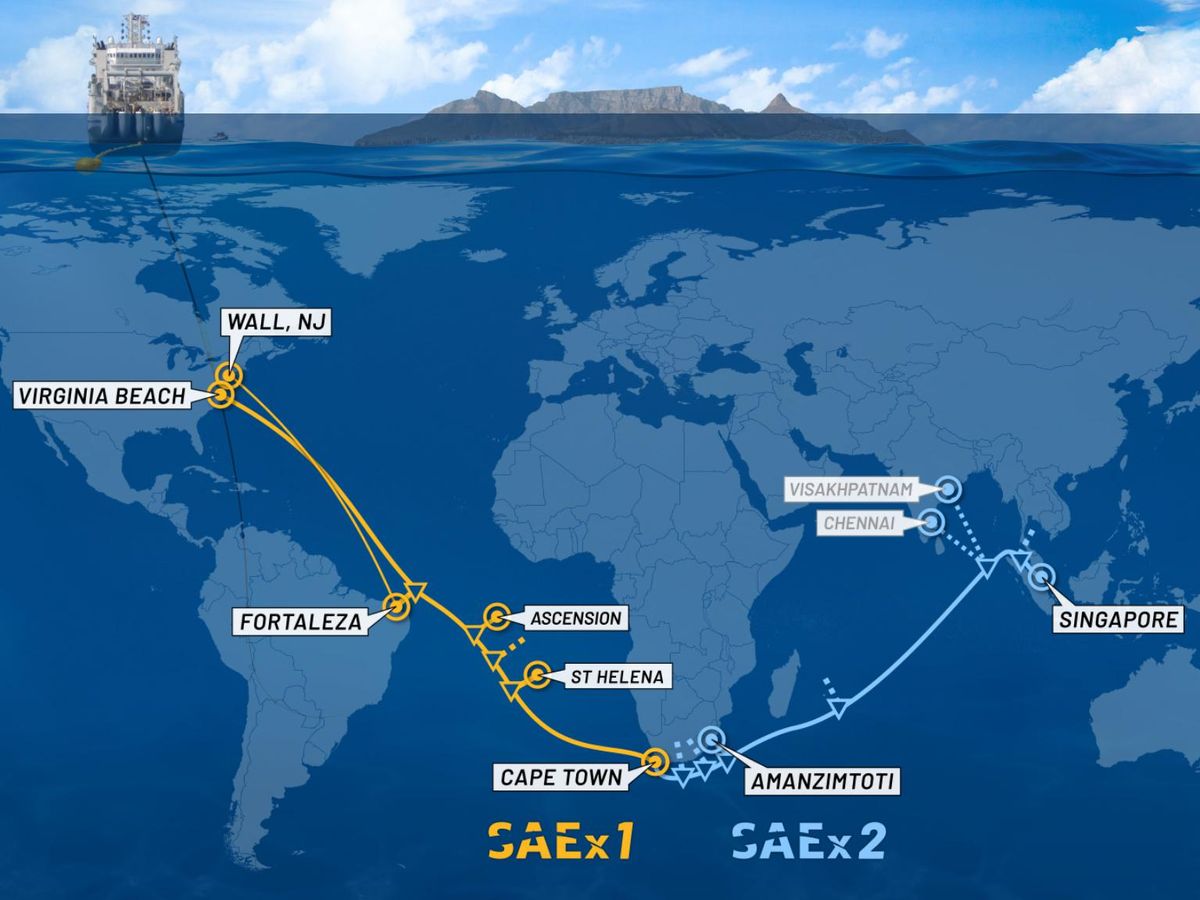The first transatlantic telegraph cable—seven copper cables, coated in latex and crudely wrapped in strands of hemp and iron—has nothing on its distant fiber-optical descendants that underpin today’s Internet. And that's setting aside that the first cable failed within weeks of beginning operations in 1858. Now there are over 1.2 million kilometers of fiber wound around the world.
Unfortunately for many Internet users, the current cable layout leaves them with a bit of a raw deal. Take Africa in particular: The continent is less a component of the cable network than an extension of it. Even as Google and Meta set their sights on building entirely new lines that will drastically boost the continent’s capacity, those lines hug well-trodden, predictable routes.
There is one effort that hopes to do what Google and Meta won’t—SAEx, or the Southern Oceans Network. But it’s been slow to come.
The first seafloor cable touched African shores two decades ago; there are dozens of such cables now. To the continent’s west, they tend to run up the coast and to Western Europe. To the east, they typically run through the Red Sea and the Suez Canal into the Mediterranean, or through the waters of the Arabian Sea before they stretch out to India and beyond.
All this means that to get from Africa to the Internet hubs of North America or East Asia, traffic has to go either through the Middle East or Europe. For one, this reinforces historical trade patterns that make Africa dependent on the countries that once conquered it. More practically, traffic going through just a few choke points is vulnerable to disruption, whether from politics or natural disaster.
We already have an example of what happens when a place is quite literally cut off from the physical Internet. Earlier this year, a volcanic eruption in Tonga severed the cable that served the island country, forcing rescue parties to rely on poor-quality satellite connections.
There is, to be fair, enough redundancy in the layout that one event won’t do to the entire African continent’s Internet what Hunga Tonga-Hunga Ha’apai’s eruption did to Tonga’s. But the risks of disruption are still heavier than for other continents, and the latest wave of cables doesn’t change that status quo.
Google’s Equiano runs from Portugal down Africa’s west coast, landing at Lagos and Cape Town. Alphabet says the cable has a capacity of 144 terabits per second. (For comparison, Google’s Durant, from Virginia to France, has a record-holding capacity of 250 Tb/s.)
Meta’s plans are even more ambitious. 2Africa surrounds the continent like a necklace, landing at over a dozen countries on all sides. Meta boldly claimed that the completed network would provide “nearly three times the total network capacity of all the subsea cables serving Africa” as of 2021. (A planned extension, Pearls, would also capture numerous countries along the Arabian Sea into the fiber-optic web.) Sections of 2Africa will have a capacity as high as 180 Tb/s.
It’s hard to say that African Internet users won’t benefit from all this Internet connectivity. But there’s reason to treat the plans with some level of skepticism. In addition to placing the cables in the hands of American Internet giants, they simply consolidate even more data and even more traffic along those existing corridors.
It leaves glaring gaps in the southern seas—specifically, the South Atlantic and the Indian Ocean.
The gaps aren’t completely empty. A few cables connect Indian Ocean islands—such as Madagascar, Mauritius, Réunion, and the Seychelles—to the African mainland. There’s also the South Africa Far East cable, running from Cape Town east across the ocean floor to India and Malaysia, but it’s two decades old. And on the other side, there are cables linking Cameroon and Angola with the cable hub that is Fortaleza in Brazil.
After SAEx was first announced in 2011, that was the initial plan: to connect South Africa to Brazil.
But that plan evolved when the project’s backers started to have other ideas of what would make a good link. That meant ramping up plans. First came a plan to extend the Brazilian cable to the United States, then a planned phase 2 cable stretching from South Africa to Singapore.
That second phase “is attractive for some people who want to get from Asia to Latin America without going through the United States for various reasons,” says John Tibbles, a consultant for SAEx. “Or, in the same way, people in the United States who want a completely alternate route from the United States to Singapore.”
Funding issues aren’t the only reason the project has been slow. “The political complexities between the United States and China have made things difficult or slowed down in the last couple of years,” says Tibbles.
It’s a familiar problem to people trying to do these sorts of projects on the African continent. Much of the continent’s digital infrastructure is built by Huawei—South Africa included, where Johannesburg is a major center of the company’s activities. Huawei faces sanctions from the United States, as well as pressure for U.S. companies not to operate with its infrastructure.
But it isn’t an insurmountable obstacle. And if all goes well, then SAEx—specifically its Asian section, the original phase 2—could proceed to construction as soon as later this year.



